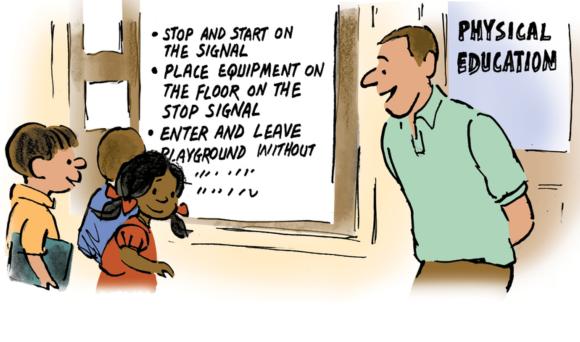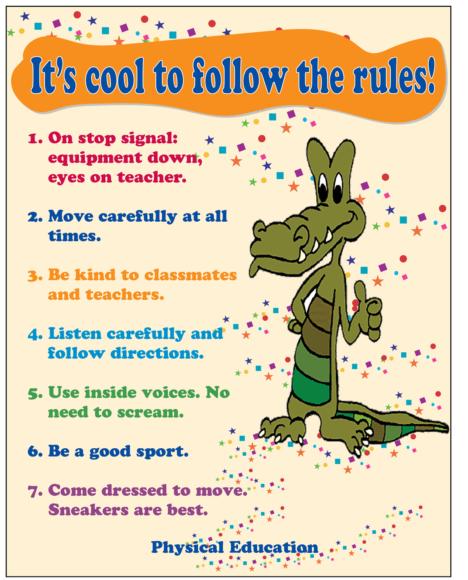Teaching Behavior Protocols
This is an excerpt from Teaching Children & Adolescents PE 4th Edition With Web Resource by George Graham,Eloise Elliott,Steve Palmer.
Deciding on the management protocols to use in your classes is relatively easy. The challenging part is teaching those protocols until students know them and they become a part of every class you teach over the entire year.
As with any teaching process, no single approach works for all teachers. However, teachers who create pleasant atmospheres seem to display certain attributes as they work on building their class environments. They are firm but warm while also being critically demanding. They also post their rules for classes to see and often discuss them so that students feel a certain degree of ownership.
Firm but Warm
At one time we believed that successful teachers threatened students: that is, that they scared them into being good. Today we know better (Bulger, Mohr, & Walls, 2002; Downing, Keating, & Bennett, 2005; Doyle, 1986; Fernandez-Balboa, 1990; Kounin, 1970). Successful teachers exhibit a certain degree of firmness: they mean what they say. At the same time, however, they are warm and caring toward the students. They don't want to frighten them, but they want them to know they mean business. Students quickly learn to discern whether teachers mean what they say. Good teachers mean what they say, and they exhibit it by not allowing their students to get away with not following the protocols. They don't get excited or hysterical or threaten, however. In calm, reassuring, firm ways, they simply and consistently communicate the message that things are going to be done a certain way and that not much else is going to happen until the protocols are learned. This is one of those skills used by effective teachers that is difficult to put into words. However, if you watched 10 teachers, you would quickly identify those who are firm but warm.
Critically Demanding
If we could write this section in flashing neon lights, we would, because this is an especially important teaching skill that makes a huge difference in the learning environment.
In addition to being firm but warm, effective teachers also are critically demanding. You can quickly recognize this quality when you see it. Teachers who are critically demanding have a built-in expectation that students follow the protocols, and they insist that they do. For example, they know how they want their students to enter the gym. When students enter that way, the lesson proceeds as planned. When they don't, these teachers don't accept their behavior. They insist (demand) that they go back and enter the gym the way they had practiced earlier.
This is especially difficult because, typically, you will want to get on with the lesson you have planned. It's hard to spend time having students go back and reenter the gym. In the long run, however, you will spend less time on these distracting events than if you hadn't spent the time reinforcing your expectations at the beginning of the year. One advantage for your students is that they know exactly what to expect. You can be consistent day after day because you know what is reasonable for your students and you expect that behavior of them.

One of the easiest ways to understand the quality of being critically demanding is to think back to when you were in high school. Did you have a curfew? What happened if you were late? If your parents or guardians were critically demanding, they followed through on the consequences you had discussed before (e.g., being grounded for a week or denied television). If your parents or guardians were not critically demanding, however, they likely let things slide and you knew that they really didn't mean what they said.
Rules - Clear, Positive, Posted
Posted rules also help with consistency. Rules are essentially brief reminders of the behavior protocols. Most teachers list five or six rules, state them in positive ways, and post them prominently (figure 2.1). Simply writing and posting them, however, is no guarantee they will be followed. They also must be practiced.
Physical Education Rules
Physical education rules might look like those in figure 2.1. One reason for posting rules, in addition to serving as reminders, is for the benefit of students new to the school. Posted rules allow you to briefly review the behavior protocols with new students. You may also video record classes in which you explained the behavior protocols and include student demonstrations. The video can then be made available to new students so that they can see exactly what is expected of them in physical education class.

Example of posted rules.
Used by permission of PE Central (pecentral.org), the premier website for physical education teachers. Our goal is to provide educational resources to teachers who, in turn, will help guide youngsters in the process of becoming physically active and healthy for a lifetime. PE Central is supported by S&S Worldwide (pe.ssww.com), a 110-year-old company dedicated to assisting teachers to motivate kids to play and learn using their innovative and educational products. http://pe.ssww.com/item/product-W12402/
Behavior videos are a good idea in places where teachers are often threatened with malpractice lawsuits. In this case, every new student should be required to view the video before participating in physical education. In extreme instances, teachers may quiz students (in writing or orally) or ask them to sign a copy of the rules, indicating that they have viewed the video. We also suggest that this behavior video be placed on the physical education section of the school website.
Locker Room Rules
Secondary programs frequently require students to change clothes in a locker room. You may need rules and protocols specific to the locker room. Here are some examples:
- Take pride in our school and keep the locker room CLEAN!
- Leave food, candy, gum, drinks, and cell phones in your locker or other space outside the gym or PE area.
- Act appropriately (keep your hands to yourself, no bad language).
- Be in the locker room when the bell rings.
- Enter and exit the locker room from the appropriate hallway.
- Dress at your locker.
- Be responsible for locking up all belongings and valuables.
Although these suggestions might seem extreme, teachers who have been involved in malpractice lawsuits will quickly recognize the benefit to posting such rules. This is especially important in schools with high rates of student turnover.
Some teachers send letters home to parents and guardians at the beginning of the school year outlining policies on dress for physical education (especially footwear), medical notes, and what the students will be learning in the coming year. These letters typically provide information about contacting the teacher if questions arise about classes, policies, or other issues (Hopple, 1998).
Developing Ownership
Rules (behavior protocols) are followed more closely when students, and parents and guardians for that matter, understand why they are necessary, and also when students have a sense of ownership of them. For this reason many teachers discuss rules with students to help them understand their importance. A video of students not following the rules can illustrate what happens when this occurs. (You will have no problem recruiting a class to help you make a video demonstrating all of the ways not to behave in the gym!) The video then becomes an excellent resource for involving students in discussions about why management protocols are important to have and follow.
In addition to sharing the rules with your students, provide the principal and classroom teachers with a copy of the rules. This is especially important if your school does not have a unified discipline plan (e.g., assertive discipline; see chapter 10). It might also be worthwhile to share the rules with parents and guardians, perhaps on the school website, especially if you plan to send notes home about students who do not follow the established behavior protocols. This will depend, however, on such factors as the philosophy of the school and the policies of the principal and the board of education.
The next chapters address many of the teaching skills effective physical educators use. The bottom line, however, is that if students do not practice the behavior protocols, as stated in the posted rules, until they become an understood and accepted way of doing business, then many of the pedagogical skills discussed later will have limited effect. Although it's not a lot of fun for you or your students to practice the behavior protocols that are critical to the development of a positive (enjoyable, fun, interesting) learning environment, it's absolutely necessary. If you want to enjoy teaching, spend time practicing the protocols. If you want to spend time nagging youngsters, skip the protocols and start trying to teach.
SHOP

Get the latest insights with regular newsletters, plus periodic product information and special insider offers.
JOIN NOW
Latest Posts
- Using double inclinometers to assess cervical flexion
- Trunk flexion manual muscle testing
- Using a goniometer to assess shoulder horizontal adduction
- Assessing shoulder flexion with manual muscle testing
- Sample mental health lesson plan of a skills-based approach
- Sample assessment worksheet for the skill of accessing valid and reliable resources


